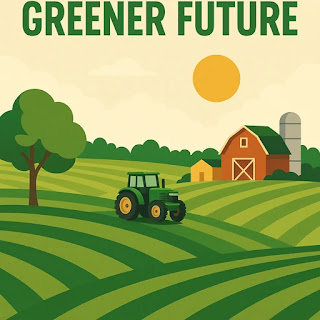Green Fields, Greener Future
In a world where the climate crisis looms large and environmental concerns grow louder, the future of farming holds a powerful key to global sustainability. Agriculture, long seen as a sector of tradition, is undergoing a profound transformation—one that not only embraces productivity but also champions environmental harmony. The concept of "Green Fields, Greener Future" is more than a catchy phrase—it’s a call to action, a vision of a sustainable tomorrow rooted in the practices of today.
The Problem with Conventional Agriculture
Traditional industrial farming has undoubtedly helped feed billions, but it has come at a cost. Monoculture farming, excessive pesticide use, deforestation, soil degradation, and high water consumption have strained our ecosystems. According to the UN Food and Agriculture Organization, agriculture is one of the largest contributors to greenhouse gas emissions globally.
If we continue on this path, the very fields that feed us may become barren.
A Greener Way Forward
“Green agriculture” isn’t just about organic farming. It’s a comprehensive approach that includes sustainable land use, efficient water management, reduced chemical inputs, biodiversity preservation, and renewable energy adoption.
Here’s how we can make our fields—and our future—greener:
1. Sustainable Farming Techniques
-
Crop rotation and intercropping improve soil health and reduce the need for chemical fertilizers.
-
Conservation tillage minimizes soil disruption, protecting it from erosion and maintaining moisture.
-
Agroforestry combines trees and crops, increasing biodiversity and providing shade, nutrients, and additional income sources.
2. Organic and Regenerative Agriculture
Organic farming avoids synthetic inputs and GMOs, but regenerative agriculture goes even further. It focuses on restoring soil health, increasing carbon capture, and enhancing water retention—literally regenerating the Earth as it grows food.
3. Water Wisdom
With freshwater scarcity on the rise, sustainable irrigation is vital. Techniques like drip irrigation, rainwater harvesting, and soil moisture sensors ensure every drop counts. Reducing runoff and recycling water are crucial steps toward resilience.
4. Smart Farming & Technology
Technology is making farms smarter:
-
Drones monitor crop health.
-
AI-driven data analysis helps predict yields and optimize inputs.
-
IoT sensors in fields provide real-time insights on weather, soil, and water needs.
These tools help reduce waste, lower emissions, and maximize efficiency.
5. Eco-Friendly Inputs
Natural fertilizers like compost and biochar enrich the soil without polluting it. Biopesticides and /integrated pest management (IPM) reduce reliance on harmful chemicals, protecting beneficial insects like bees and butterflies.
6. Local & Seasonal Food Systems
Supporting local farmers and consuming seasonal produce reduces transportation emissions and promotes regional biodiversity. Farm-to-table movements, urban farming, and community-supported agriculture (CSA) are all steps toward greener food systems.
Farming for the Planet, Not Just Profit
Transitioning to sustainable agriculture isn’t just an environmental need—it’s an economic and ethical imperative. Greener fields mean:
-
Healthier food for consumers
-
Resilient livelihoods for farmers
-
Protected ecosystems for future generations
Governments, corporations, farmers, and consumers must all work together to shift priorities from short-term yields to long-term balance.
The road to a greener future begins with the soil beneath our feet. By choosing sustainability, investing in innovation, and respecting nature’s rhythms, we can transform agriculture from a source of environmental strain into a force for global restoration.
“The ultimate goal of farming is not the growing of crops, but the cultivation and perfection of human beings.” — Masanobu Fukuoka
Read More :
In the Field of Sacrifice: Unsung Heroes of Farming




Comments
Post a Comment